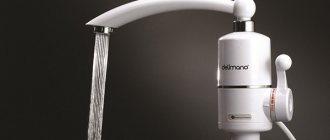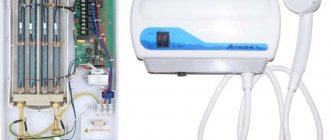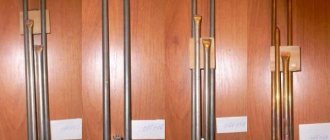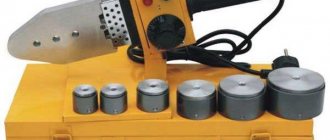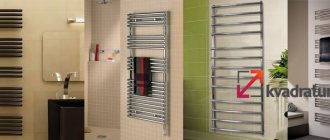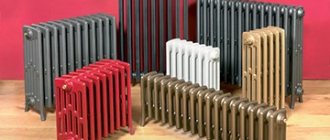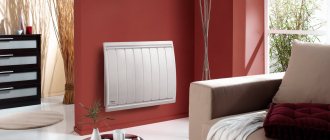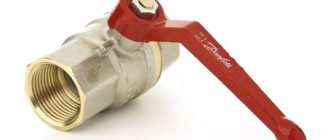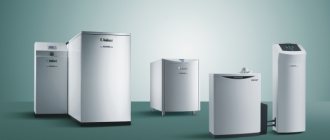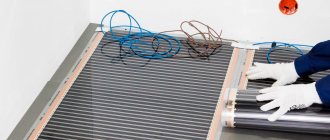Although it is no longer common for global water cut-offs in summer to occur, people in some cities still have to deal with hot water interruptions. The owners of suburban real estate also need to puzzle over how to enjoy all the benefits of civilization, while enjoying nature and fresh air.
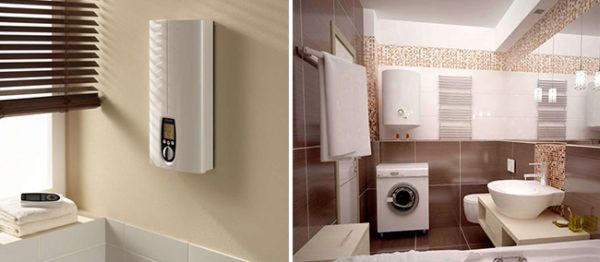
The optimal solution is a water heater. However, if earlier it was possible to choose from just a few models that work on the same principle, today the assortment is more than varied.
Gas or electric water heater
In this matter, everything is pretty simple. The days of gas installations are over. This is not the safest equipment and also requires compliance with established standards. For example, there is SNiP 42-01-2002 (it was adopted instead of 2.04.08-87), which talks about gas distribution systems, there is a point where it says that gas appliances are not recommended to be installed in some rooms. For example, in bathrooms less than 6 m2. Also, a chimney must be present in the room, since the columns are not connected to the hood. There are many other requirements as well.
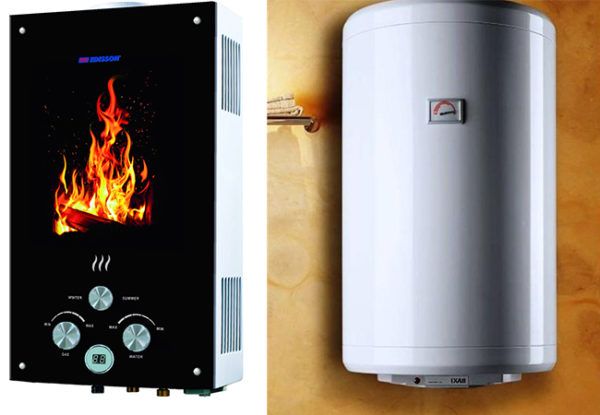

Electric water heaters are more modern systems that are much easier to operate and maintain. However, there are many such models. Before deciding on the main characteristics of boilers, it is worth deciding which type of equipment is better.
Boiler or water heater: what are the differences?
Any home requires comfortable conditions, and hot water is an important factor in this. But for city apartments and country houses, this problem is not always solved with the help of centralized water supply. For this, special water heaters are used, the power of which and the design may be different. Among the equipment offered on the market, there are various options for devices that differ not only in the power of the water heater, but also in the principle of water heating.
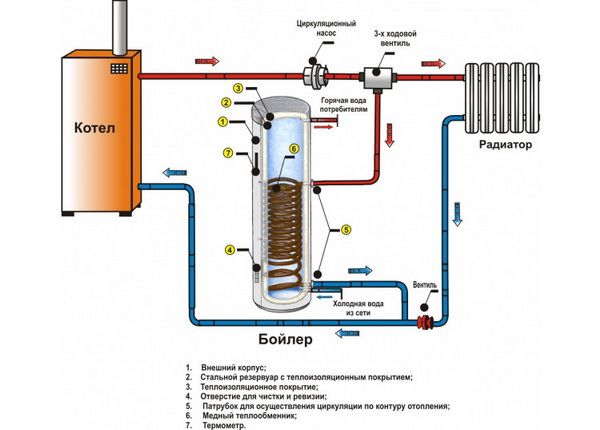

Stationary boiler operation diagram.
But what is the difference between a boiler and a water heater? Which one can be used for installation in a city apartment, and which one is suitable for providing hot water to a large system and a private house as a whole? We will answer this question by considering the individual characteristics and features of such equipment.
Features of the storage boiler
What is the difference between a boiler and a water heater? They are similar in many ways, but there are some differences. If the coolant in the heater is heated from a special heating circuit, then such equipment is an indirect heating boiler. What is this?
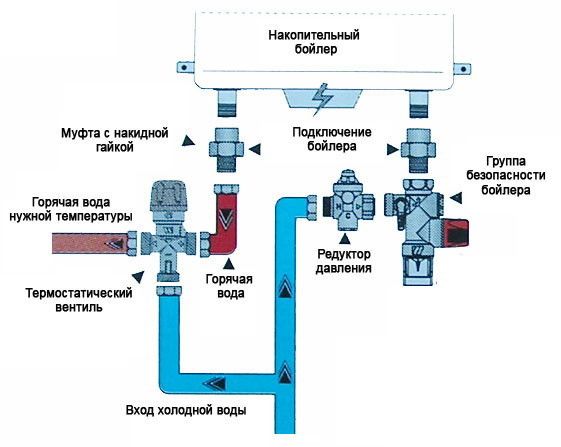

Storage boiler connection diagram.
A coil is installed in a cylindrical metal body, which is covered with enamel on top. He is such a coolant, that is, a heater for water. When this type of boiler is connected to the heating system, several problems can be solved at once. This is not only the provision of hot water, but also the supply of heat carrier for the heating system.
The storage boiler is a device in the form of a cylindrical metal tank, the capacity of which depends on the model. Some models can hold several hundred liters. For large boiler houses, large-scale vertical installations are used, and for private houses it is allowed to use more modest equipment, the power of which is much lower.
To place the boiler, in any case, you will have to allocate a separate room, you can do this in a house on the basement floor, or you can install it in separate outbuildings.
Such a storage boiler must be attached to the wall surface.
Its body is made of plastic or stainless steel. The surface is steel, painted with special paints or covered with a layer of enamel. But when choosing, you will have to take into account that steel is susceptible to corrosion, so you need to choose its stainless types, and not ordinary ones. In this case, the service life of the container will be much longer.
The design of the boiler is as follows: in the barrel itself there is a coil, which is made of brass or steel, it resembles a spiral in shape, but the increased number of turns allows you to heat the water much faster. The coil is displaced closer to the bottom of the boiler, since cold water tends to go down when heated, that is, the water heats up evenly and quickly.
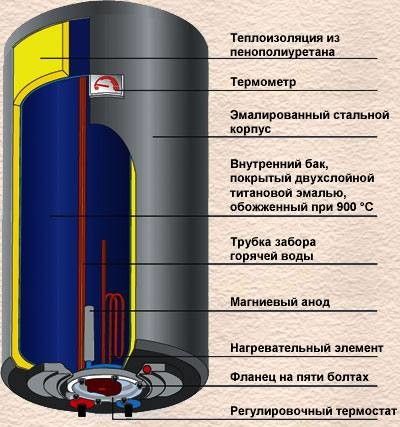

Diagram of the storage boiler device.
There are models that have two heating elements at once, for example, indirect heating devices. One of these heat exchangers is fed to the heat pump, and the other to the heating system.
The operating principle of the storage boiler is simple. Cold water is pumped into the lower part of the tank, after which it is gradually heated due to the heat exchanger. For hot water, the outlet is located on top. The device is equipped with a magnesium anode, which prolongs the service life.
There are some models of boilers without a coil. Such equipment consists of two tanks, in one of them (smaller) water is heated, the walls between the tanks are a heat exchanger.
Electric storage water heater: looking for differences
Today many people prefer to use an electric boiler. This is often called a storage water heater powered by an electrical network. Such equipment differs in size, the volume of the tank can range from 5 liters to 120, it all depends on the needs of the living family. If you need to put equipment for washing dishes in the kitchen, then it is best to choose a small heater for 5 liters, but a large one, designed for a volume of up to 120 liters, can be used not only for the bathroom, but also for the kitchen at the same time.
The capacity of such a storage tank may be different, in this case it is necessary to choose exactly the equipment that suits you best, both in terms of energy consumption and in volume. For an apartment, this capacity may not be high, but for a private house it is usually quite significant parameters. Usually, the use of a storage heating tank is recommended for a family of three to six people, a volume of 100 liters is quite enough for daily needs.
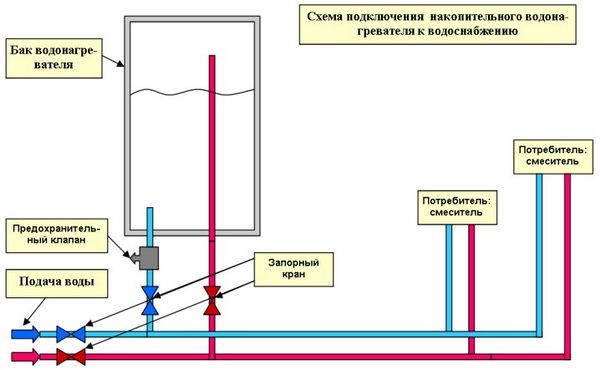

Storage water heater connection diagram.
The use of an electric storage device is preferable in many cases. Inside the device, in addition to the installed thermal electric heater, the so-called heating element, there is also a magnesium anode, a special thermostat. This allows you to heat the water to the required, comfortable temperature. There is a kind of storage heater, which is equipped with a dry heating element, that is, the heating element for such equipment is not in the water, but outside its limits, it heats only the internal container. The service life of such a storage heater is much longer, but the cost of such units is also higher.
Gas storage devices have completely different power and characteristics. They are classified according to the following characteristics:
- for forced draft with a closed combustion chamber of fuel (gas);
- to ensure natural draft, that is, with an open chamber for fuel (gas) combustion.
The cost of such equipment is quite high, and the installation is of a certain complexity. During installation, many factors should be taken into account, this is not only the power of the equipment, but also the provision of exhaust, other safety conditions.
Why do gas water heaters continue to be popular anyway? The point is that they run on cheaper gas, that is, their use is more economical, and this is important for a large private house.
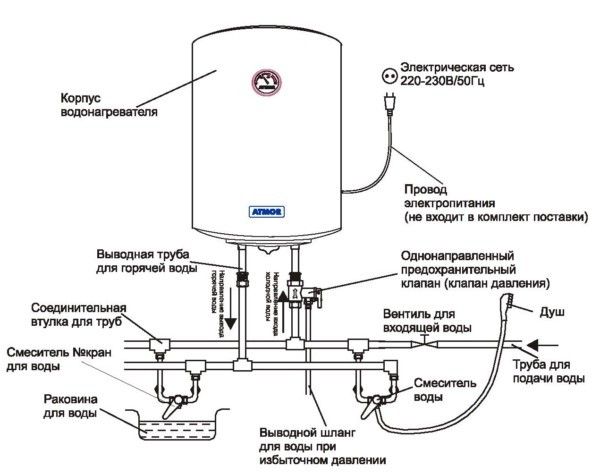

Electric water heater operation diagram.
The use of a storage water heater allows you to solve such a problem as ensuring uninterrupted supply of hot water, which is often necessary not only for a private house, but also for a city apartment. In this case, the use of flow-through systems is ineffective, and if there are several draw-off points, then it is best to use heaters with tanks, the power of which corresponds to the stated needs of consumers.
But many are not happy with the other situation. For example, if someone is washing in the bathroom, and at this time a faucet for washing dishes is turned on in the kitchen, then a sharp drop in temperature is immediately observed. The situation can be corrected by installing an indirect type water heater.
For a large family, such equipment is simply irreplaceable, especially if it is installed in a private house, where there is not one bathroom, but several. This allows all family members to normally use hot water, who now do not have to wait for their turn.
Today, storage heaters of the indirect type are the most popular option for installation. They are compact, easy to install and use, and provide hot water at the required temperature.
How does a boiler differ from a typical water heater?
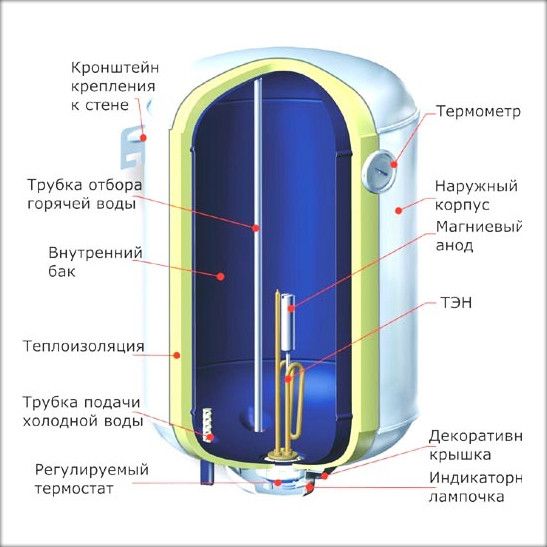

Water heater device diagram.
So how can a boiler familiar to many differ from a water heater, if the principles of their operation are almost the same? Quite often, due to some external similarity and almost the same use, the boiler is also called a storage water heater. But inside a real water heater there is only a heating element, but the boiler has a heat exchanger, into which the heat carrier is supplied from the boiler. The upper part of the boiler tank has an anode holder, a flange with which a thermostat sensor and a thermometer are placed inside. That is, there are also quite significant differences in design.
For the boiler, the heat source can be electricity, gas (natural, liquefied), diesel fuel, solid fuel (firewood, coal and peat briquettes, ordinary coal, pallets). The main similarity between boilers and water heaters is the presence of a stainless steel or enamelled water tank, in which the water is heated. But unlike a water heater, a boiler is designed to heat a fairly large volume of liquid, some tanks are designed for three thousand liters. Naturally, the power of such a unit is greater.
Basically, the use of such a massive boiler is intended for a house with several water points. A small and compact water heater is ideal for a city apartment, providing water at a comfortable temperature. For cottages, indirect water heaters are ideal, which are quite large in size, but at the same time they are economical.
Take your time with the purchase of a device for heating water, analyze your needs. We hope that our advice will help you choose the right equipment for your particular situation.
Instantaneous water heater
In this case, we are talking about direct heating of water, at the moment the tap is turned on. There are three types of instantaneous water heaters:
- Stationary systems.Products are large in volume and require a separate installation space.
- Water heaters nozzles. They are installed directly on the crane. It is easy to guess that they are enough only to wash their hands.
- Electrically heated tap. It is a separate mixer. In fact, the water heats up according to the same principle as the nozzles, only faster. This means that the equipment has a higher performance.
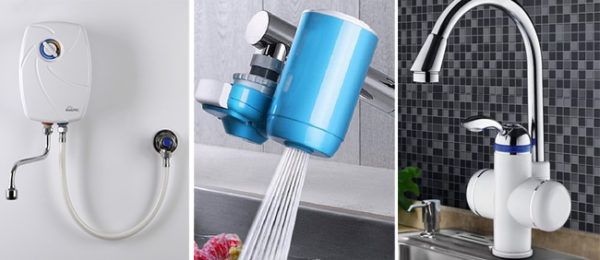

Owners of suburban real estate give such models because of the low cost. But, such heaters have a lot of disadvantages. First of all, they fail much faster. In addition, the flowing power of such units is at least 3 kW. And if you want to take a shower, then the power of such a flume exceeds 10 kW. Not every power grid can handle such loads. For a storage boiler, this parameter ranges from 1.4 to 2.5 kW. Therefore, it is much easier and more profitable to buy this particular type of boiler.
Strengths and weaknesses of an electric instantaneous water heater
And so, based on the principle of operation and design features, the clear advantages of the flow-through type will be as follows:
- no need to wait and save water (turn on the tap and use hot water as much as necessary);
- compactness (no need to allocate a lot of space for placement);
- lack of maintenance (no water tank and no problems with limescale on the heating element and walls);
- no solid wall mounting required (low weight allows you to mount the case to any wall).
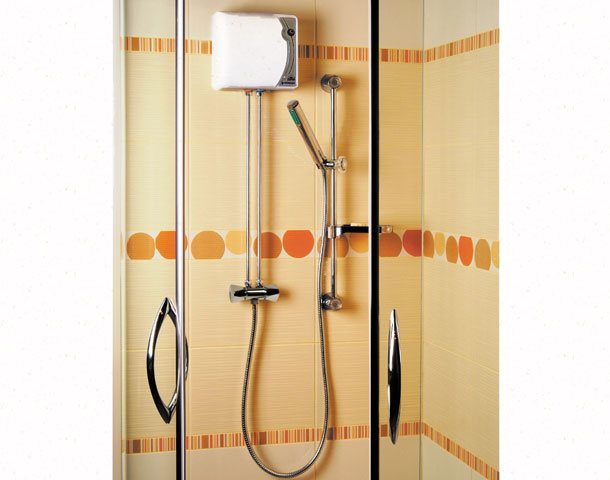

In order not to be disappointed in the chosen water heater, correctly calculate the required power. In old apartments with poor wiring, it is allowed to install equipment with a power below 6 kW, which will only allow you to wash dishes and wash your face. For a shower and, moreover, for a bath, it is better to choose a more powerful heater. If this is not possible, then consider storage boilers. The low-power "protochnik" is convenient for giving, especially taking into account seasonal operation.
The disadvantages of the flow-through type include the following:
- stringent power supply requirements and strict installation rules (only valid for high power models);
- the stronger the pressure of the water, the more power the device should be (if you open the tap strongly, then the weak "flower" simply will not have time to heat the water to a comfortable temperature);
- most models are designed only for servicing one draw-off point (extended functionality will significantly affect the cost of the "water heater");
- for pressurized varieties, a flow of water of a certain strength is required (it is important to take into account in a summer cottage and rural areas).
Instantaneous water heaters are good in case of a temporary shutdown of hot water. They do not take up much space, are not conspicuous and will instantly heat the water when needed. However, for an apartment or a private house without centralized hot water supply, this option is far from the best.
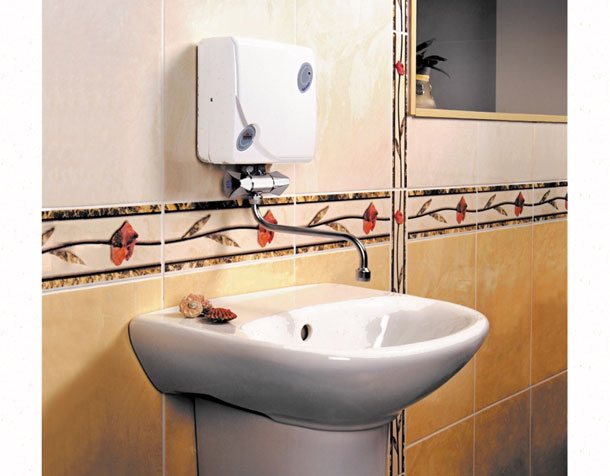

Storage water heater
Such systems can most often be found both in country houses and in apartments. In this case, water is drawn into a tank, the volume of which can range from 30 (for the kitchen from 5 liters) to 210 liters. Inside the unit there is a dry (heating element does not come into contact with water) or wet (heating element in contact with water) type heating element, which heats the entire volume of liquid. As soon as the water cools down, the boiler heats it up again. As a result, you can not only wash the dishes, but also take a full shower and bath.
Helpful! It is worth choosing a model with a dry type heating element, since such boilers are more durable.
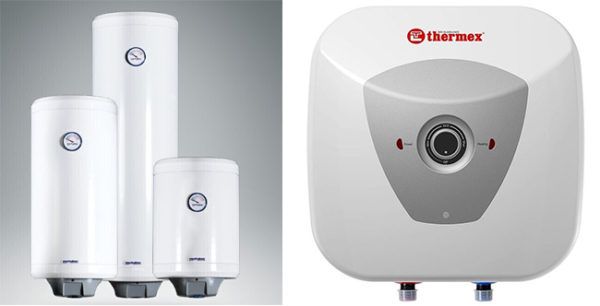

Appliances of this type are valued for their low energy consumption. However, such systems require periodic maintenance and are more expensive. Another drawback is heat loss.Even if you buy the most modern case, the heat energy will "go away" a little.
Helpful! Some people solve this problem by turning on the boiler a few hours before showering and turning it off after bathing. However, in this case, you will not be able to spontaneously take a bath.
Storage water heaters come in a variety of shapes and types of installation: oval, flat, square, wall-mounted, floor-standing, horizontal. Thanks to this, you can choose a model even for the most modest room.
What is the difference between a boiler and a water heater?
For city apartments and country houses, the problem of uninterrupted supply of hot water is not always solved with the help of centralized water supply. For this, special water heaters are used, the power of which and the design may be different. Among the equipment offered on the market, there are various options for devices that differ not only in the power of the water heater, but also in the principle of water heating.
But what is the difference between a boiler and a water heater?
Which one can be used for installation in a city apartment, and which one is suitable for providing hot water to a large system and a private house as a whole? We will answer this question by considering the individual characteristics and features of such equipment.
Features of the storage boiler for indirect heating
What is the difference between a boiler and a water heater? They are similar in many ways, but there are some differences. If the coolant in the heater is heated from a special heating circuit, then such equipment is an indirect heating boiler. What is this?
A coil is installed in a cylindrical metal body, which is covered with enamel on top. He is such a coolant, that is, a heater for water. When this type of boiler is connected to the heating system, several problems can be solved at once. This is not only the provision of hot water, but also the supply of heat carrier for the heating system.
The storage boiler is a device in the form of a cylindrical metal tank, the capacity of which depends on the model. Some models can hold several hundred liters. For large boiler houses, large-scale vertical installations are used, and for private houses it is allowed to use more modest equipment, the power of which is much lower.
To place the boiler, in any case, you will have to allocate a separate room, you can do this in a house on the basement floor, or you can install it in separate outbuildings.
Such a storage boiler must be attached to the wall surface.
Its body is made of plastic or stainless steel. The surface is steel, painted with special paints or covered with a layer of enamel. But when choosing, you will have to take into account that steel is susceptible to corrosion, so you need to choose its stainless types, and not ordinary ones. In this case, the service life of the container will be much longer.
The design of the boiler is as follows: in the barrel itself there is a coil, which is made of brass or steel, it resembles a spiral in shape, but the increased number of turns allows you to heat the water much faster. The coil is displaced closer to the bottom of the boiler, since cold water tends to go down when heated, that is, the water heats up evenly and quickly.
There are models that have two heating elements at once, for example, indirect heating devices. One of these heat exchangers is fed to the heat pump, and the other to the heating system.
The operating principle of the storage boiler is simple. Cold water is pumped into the lower part of the tank, after which it is gradually heated due to the heat exchanger. For hot water, the outlet is located on top. The device is equipped with a magnesium anode, which prolongs the service life.
There are some models of boilers without a coil.Such equipment consists of two tanks, in one of them (smaller) water is heated, the walls between the tanks are a heat exchanger.
Electric storage water heater: looking for differences
Today many people prefer to use an electric boiler. This is often called a storage water heater powered by an electrical network. Such equipment differs in size, the volume of the tank can range from 5 liters to 120, it all depends on the needs of the living family. If you need to put equipment for washing dishes in the kitchen, then it is best to choose a small heater for 5 liters, but a large one, designed for a volume of up to 120 liters, can be used not only for the bathroom, but also for the kitchen at the same time.
The capacity of such a storage tank may be different, in this case it is necessary to choose exactly the equipment that suits you best, both in terms of energy consumption and in volume. For an apartment, this capacity may not be high, but for a private house it is usually quite significant parameters. Usually, the use of a storage heating tank is recommended for a family of three to six people, a volume of 100 liters is quite enough for daily needs.
The use of an electric storage device is preferable in many cases. Inside the device, in addition to the installed thermal electric heater, the so-called heating element, there is also a magnesium anode, a special thermostat. This allows you to heat the water to the required, comfortable temperature. There is a kind of storage heater, which is equipped with a dry heating element, that is, the heating element for such equipment is not in the water, but outside its limits, it heats only the internal container. The service life of such a storage heater is much longer, but the cost of such units is also higher.
Gas storage boilers have completely different power and characteristics. They are classified according to the following characteristics:
for forced draft with a closed combustion chamber of fuel (gas);
to provide natural draft, that is, with an open chamber for fuel (gas) combustion.
The cost of such equipment is quite high, and the installation is of a certain complexity. During installation, many factors should be taken into account, this is not only the power of the equipment, but also the provision of exhaust, other safety conditions.
Why do gas water heaters continue to be popular anyway? The point is that they run on cheaper gas, that is, their use is more economical, and this is important for a large private house.
The use of a storage water heater allows you to solve such a problem as ensuring uninterrupted supply of hot water, which is often necessary not only for a private house, but also for a city apartment. In this case, the use of flow-through systems is ineffective, and if there are several draw-off points, then it is best to use heaters with tanks, the power of which corresponds to the stated needs of consumers.
But many are not happy with the other situation. For example, if someone is washing in the bathroom, and at this time a faucet for washing dishes is turned on in the kitchen, then a sharp drop in temperature is immediately observed. The situation can be corrected by installing an indirect type water heater.
So how can a boiler familiar to many differ from a water heater, if the principles of their operation are almost the same?
Quite often, due to some external similarity and almost the same use, the boiler is also called a storage water heater. But inside a real water heater there is only a heating element, but the boiler has a heat exchanger, into which the heat carrier is supplied from the boiler. The upper part of the boiler tank has an anode holder, a flange with which a thermostat sensor and a thermometer are placed inside.That is, there are also quite significant differences in design.
For the boiler, the heat source can be electricity, gas (natural, liquefied), diesel fuel, solid fuel (firewood, coal and peat briquettes, ordinary coal, pallets). The main similarity between boilers and water heaters is the presence of a stainless steel or enamelled water tank, in which the water is heated. But unlike a water heater, a boiler is designed to heat a fairly large volume of liquid, some tanks are designed for three thousand liters. Naturally, the power of such a unit is greater.
What volume of a water heater should be
Boilers for 5-10 liters are usually used only for the kitchen. That is, they will only be enough to wash your hands and dishes. For the bathroom, it is worth choosing models from 30 liters. This volume is enough for one person. For two, 50 liters is enough. But if guests come to you, then someone will have to wait while the boiler heats up the next batch of water.
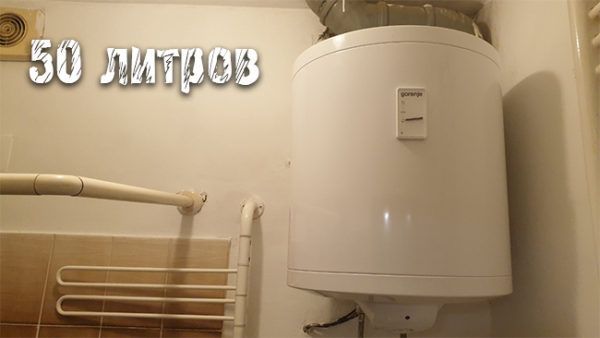

80-100 liters is enough for a family with children, plus you can wash dishes. Large 150 liter boilers are not so popular. Such models are used to connect to a larger number of water intake points. Well, the largest water heaters, with a volume of more than 200 liters, can serve several families. But in addition to the volume, it is worth clarifying other characteristics.
Which water heater is more economical to use?
Having analyzed the advantages of heaters, it is easier to make the right choice when buying. Which device will be more economical to operate? If we approach this issue from the point of view of price, then this is a flow-through water heater with a capacity of no more than 6 kW. But in the case when a more powerful device is needed, it is better to opt for installing a more functional boiler.
The following indicators affect the price of the storage device:
- the material from which the tank is made;
- displacement;
- design.
The amount of energy used by instantaneous and storage type water heaters is approximately the same. In flow-through heaters, water heats up much faster thanks to powerful heating elements, as soon as the tap was closed, electricity was no longer consumed. In storage-type installations, the water heats up slowly, since the heating elements are less powerful, but the heating process continues constantly, even when hot water is not required. At the same time, people who have a flow heater installed use hot water for an unlimited time. The conclusion is this: to heat the same amount of water to a given temperature, all heating devices consume electricity in equal amounts.
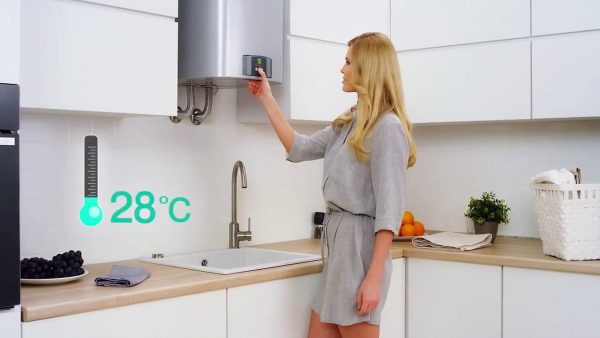

You can set the required temperature
Boiler options
Standard models usually have thermal limiters, but otherwise they work in automatic mode. The user only selects the heating intensity. But if you prefer flowing models, then you need to make sure that they are also equipped with a child lock.
Important! You cannot purchase an instantaneous water heater that is not equipped with temperature controllers and sensors. Otherwise, the risk is quite high that someone in the household will get burned.
You can also save on electricity if the water heater is capable of operating in ECO mode. In this case, it is not necessary to turn it off, since the unit will independently try to reduce energy consumption.
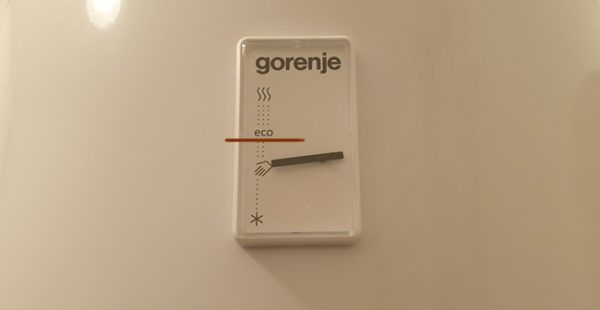

There are more expensive models with a remote control on sale. This option should be used if you plan to install the equipment in a hard-to-reach place (for example, in a closed niche).
Moisture protection class
Since the unit will be in a humid environment, you need to make sure that its housing is securely protected.Therefore, it is worth paying attention to such markings as IP31. As a rule, the first number indicates how well the product is protected from the ingress of foreign objects:
- If the number 1 is indicated immediately after the letters IP, then this indicates that the unit is resistant to large objects the size of a palm.
- 2 - resistant to smaller objects, no more than a finger.
- 3 - small particles of no more than 1 mm2 cannot enter the housing.
- 4 - the case is reliably protected even from dust.
The second number will tell you how the case is protected from moisture:
- 0 - the product is not protected from water in any way.
- 1 - the boiler body is resistant only to top leaks.
- 2 - splashes flying at an angle of 60 degrees cannot enter the water heater.
- 3 - reliable protection against splashes from any angle.
- 4 - water will not penetrate into the housing, even if the shower is directed at it.
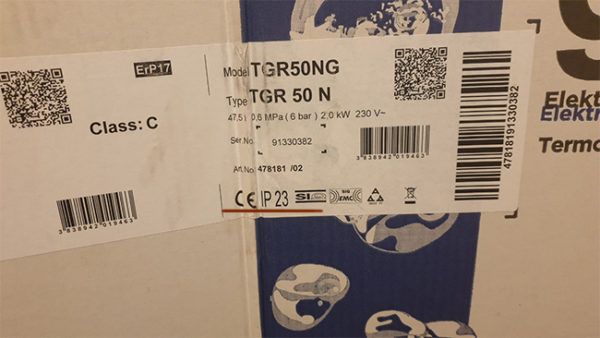

Features of the storage water heater device, advantages and disadvantages
The storage water heater consists of a metal tank placed in a heat-insulated casing. The tank has two branch pipes - inlet and outlet. The boiler is connected to the water supply system by means of the inlet pipe. The outlet pipe is used to connect the water heater to the hot water supply line. The volume of the boiler tank depends on the need for hot water in the apartment or house, which is determined by the number of residents. The most popular models of storage water heaters have a volume of 15 to 100 liters. The tank is made of durable heat-resistant steel. Its inner surface is coated with cermet or enamel to protect it from corrosion. Models of electric water heaters are also available with a stainless steel tank. The quality of the tank directly determines the service life of the storage boiler.
Heating of water in models of this type is performed by a heating element, the power of which is usually 1-2 kW. In modern storage water heaters, "dry heating elements" are used, placed in an enamel flask and not in contact with water. This design extends the life of the heating element. A magnesium anode is used to protect the surface of the inner walls of the boiler from scale formation. The preset temperature of water heating in storage models of water heaters is provided by a thermostat-based control system. There are also indirect storage water heaters. They provide for heating not only a heating element, but also a heat exchanger connected to the heating circuit. This allows you to reduce the consumption of electricity for hot water supply during the heating period.
The principle of operation of storage devices for heating and supplying water is as follows. When the storage boiler is started for the first time after installation, its tank is filled with water and is constantly under pressure acting in the water supply system. Then the heating element turns on, which carries out heating. After heating the water to the set temperature, the heating element is automatically turned off. The presence of thermal insulation allows you to maintain the temperature inside the tank without water consumption for a long time.
When the user opens the tap, heated water from the storage tank is fed to the mixer. The intake is made at the top of the tank, and cold water enters it from the bottom. Thus, cold water gradually displaces hot water. When the temperature in the tank drops to the set value, the thermostat automatically turns on the electrical device of the water heater and resumes heating.
Advantages of storage water heaters:
- The low power of the heating element does not require a dedicated boiler connection. The device can be connected in an apartment to a standard 220 V electrical outlet.
- The volume of the tank allows you to serve several points of water intake and give out a significant amount of hot water.
- Stable heating of water, regardless of its temperature at the inlet to the water heater.
- Long-term maintenance of the set temperature due to the thermal insulation of the tank. If the intake is not carried out, the water cools down by 1-2 ° C per hour, which reduces the energy consumption for heating.
The disadvantage of models of storage-type water heaters, in comparison with flow-through ones, is that the supply of hot water in them is limited by the volume of the tank, and with a long intake, its temperature gradually decreases. Heating water in a storage boiler takes time. So, a water heater with a tank volume of 100 liters heats water to a temperature of 60 ° C for about 2 hours. As the liquid cools, the thermostat automatically turns on the heating element for heating, so electrical energy is consumed even without water intake. The volume of the tank also determines the large dimensions of the storage water heater, which complicates its installation.
Tank material
First of all, it should be noted that the internal tank is not intended to be repaired. However, there is no way in the store to see what it looks like. But on the other hand, you can determine the quality of the material based on the warranty period for the water heater:
- From 1 to 5 years (very rarely reaches 7). Most likely, the inner tank is enamelled. This is not the best option.
- 5 to 10 years old. Stainless steel can boast of such indicators. This is the preferred option.
Helpful! Also, some manufacturers write that the inner tank is made of bio-glass porcelain. In fact, it is glass enamel with a prettier name coined by resourceful marketers.
On the outside, the case is usually made of steel and painted white. External parameters are not related to the operation of the unit, so you can choose to your taste.
Productivity and water consumption
These parameters depend on how intensively you plan to operate the boiler. For example,:
- If you choose a water heater only for washing dishes or hands, then 2-4 l / min is sufficient.
- For the operation of the shower cabin, 4-8 l / min is more than enough.
- To take a bath, you will need a unit of higher power, producing about 8-10 l / min.
- To service several rooms at once, it is indefinable to determine the room with the highest water consumption and multiply the resulting figures by 1.5.
Extra options
There are a few more things to look out for when choosing a water heater:
- Maximum temperature. As a rule, storage-type heaters heat water up to 60-85 degrees. But do not assume that the higher the number, the better. The fact is that at temperatures above 60 degrees, scale begins to form. This means that the unit will fail faster. The best option is a model in which you can independently set the maximum temperature threshold and set it to 55 degrees (boilers with “Eco” mode also adhere to this temperature).
- Built-in RCD. Since we are talking about electricity and water, you need to protect yourself. The RCD will prevent possible electric shock if the water heater fails. Such systems are installed in the models of the most popular manufacturers (Ariston, Polaris, Gorenje, Electrolux and others).
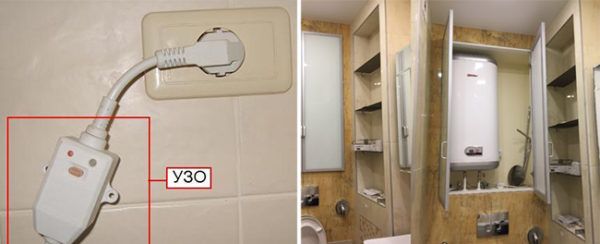

- Frost protection. This option is very relevant for a changeable climate, especially if the boiler is installed in a country house. It is best to purchase a model that will not allow the water temperature to drop below +6 degrees. If this happens, the unit will turn on by itself and heat the water to the required +10 degrees.
There are also a few more tips worth paying attention to.
What are the advantages of electric storage water heaters
The advantages of the accumulative type include:
- low power of the device (up to 3 kW), which allows it to be connected to a regular outlet without replacing the electrical wiring;
- the ability to serve multiple water points without sacrificing comfort;
- practicality at any time of the year (the heating element heats the water to the specified value, regardless of the initial temperature).
Sometimes the advantage of boilers is the economical energy consumption. However, this is very relative, even with the low power. An instantaneous water heater will not work and waste energy if the apartment is empty on a working day and the tap is closed. What can not be said about the accumulative, which throughout the day will keep the temperature at a certain level, periodically turning on and heating the water. Moreover, if you turn it off in the morning, then after returning from work, you will have to wait a few more hours for the water to heat up. Therefore, you should not focus too much on energy costs.
Of the shortcomings, the following are more often noted:
- decent dimensions of the device (if the models for 10 - 15 liters can still be called compact, then this cannot be said about the rest);

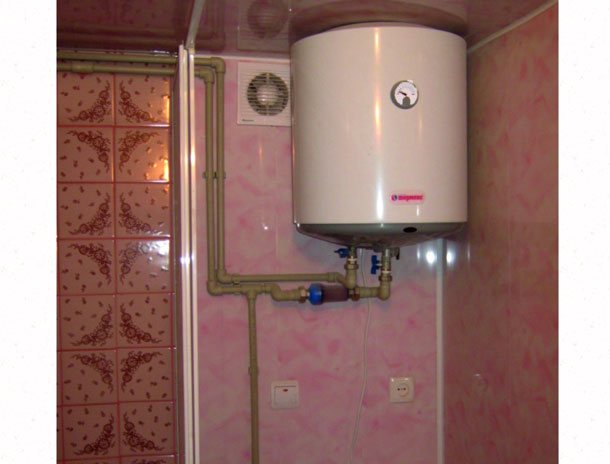
- the significant weight of the tank requires a corresponding solid attachment to the load-bearing wall;
- your comfort is strictly limited by the volume of the tank (therefore, it is important to make the correct calculations so that this volume is enough for the whole family);
- the equipment needs regular maintenance (removing plaque from the walls of the tank and from the surface of the heating element, replacing the electrode; if the water is very hard, then you need to install filters to soften);
- tendency to the appearance of a musty odor (if the water heater is rarely used, then the water in the tank may stagnate and acquire an unpleasant musty smell);
- you cannot instantly get hot water during an emergency shutdown (whatever one may say, but the device needs some time to heat the water in the tank).
The storage water heater, despite a number of nuances, is the most reliable and independent. Its operation is not influenced by external factors (weak water pressure, voltage drops, low temperature of incoming water in winter). With the right choice and proper care, you will never be disappointed in this device. Large-volume storage boilers are installed in private houses with autonomous provision.
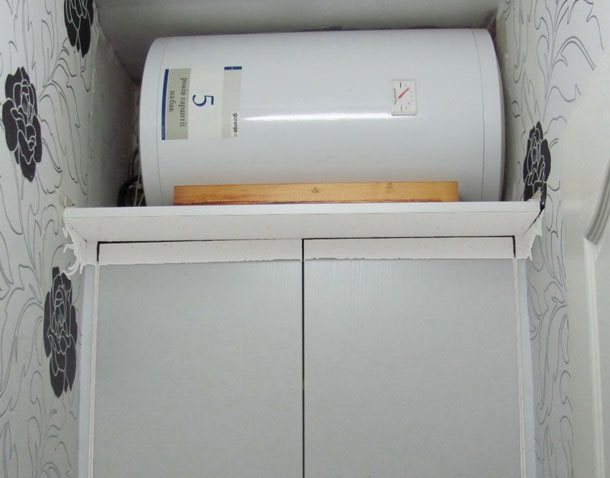

To finally determine what is best for you, let's compare instantaneous and storage water heaters in several parameters.
Features of choosing a boiler
Before buying a water heater for a country house, you should consult with an electrician. The fact is that the water heating system requires a separate line. Accordingly, it is necessary to determine how much power is generally allocated to the house. For example, if you live in an old house with 16A plugs, then you cannot choose a boiler with a capacity higher than 3.5 kW. Accordingly, the instantaneous water heater will most likely not be able to be installed.
If we are talking about a new building, then plugs at 32-40A can be installed in it. This means that a boiler with a capacity of no more than 6 kW can be installed in such a house.
It is also worth taking care of accounting for the working pressure. In some models, sensors are installed that do not react in any way if the water supply is too weak. Despite the fact that most modern water heaters operate at 0.5 bar, it is recommended to take this nuance into account.
Of course, before buying a boiler, you need to decide exactly where it will be installed. Based on this, it will be easier to determine the dimensions and shape of the product body. Also, preference should be given to trusted manufacturers.
The difference between instantaneous and storage water heaters
Consider the differences between the two types of water heaters:
- Apparatus dimensions. The flow-through heater is smaller in size, light in weight, therefore it is compact and takes up little space. The storage-type heater is of modest size with a volume of 10 liters, and can reach impressive dimensions with a tank of 200 liters.
- Power. They differ the most in this parameter. Here the boiler undoubtedly outperforms the flow heater.Its power is from 2 to 3.5 kW, and the average power of the flow-through device is about 8 kW. If the wiring in the house is old and weak, then it is better not to risk it with the installation of a flow heater.
- Water pressure. When using a flow-through apparatus, a good water pressure is required. In apartment buildings, there is a weak pressure on the upper floors. Therefore, it makes no sense to install such a device in such apartments. But the boiler works at any pressure.
- Installation. No special skills are required to install an instantaneous water heater; you can install it yourself. An exception is gas heaters and those models that are installed directly into the riser. But the boiler is not easy to install, so it is better to invite a specialist.
- Cost. In this, flow-through heaters are more profitable, the price depends on the power of the device. Savings are more expensive.
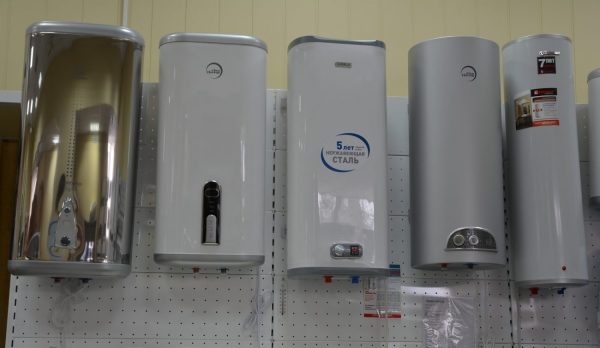

Water heaters differ from each other
Best water heaters
In short, users distinguish several models of different types:
- Electrolux Smartfix 2.0 6.5 TS. Compact instantaneous water heater with a stainless steel tank costing about 2,600 rubles. It heats water up to 80 degrees. The power is 6.5 kW. The unit is equipped with a thermostat. Suitable in case of a sudden shutdown of water.
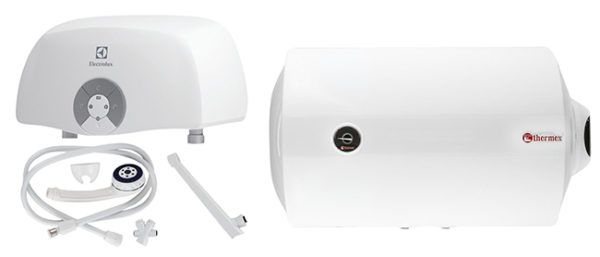

- THERMEX ERS 80 H Silverheat. This is a horizontal storage water heater. The inner tank is made of bio-glass porcelain. The maximum heating temperature is 75 degrees. The unit is equipped with an RCD, thermometer and indicators. It costs about 8,500 rubles.
- Stiebel Eltron HFA / EB 80 Z. One of the highest quality, but also expensive water heaters. It costs more than 100,000 rubles. But this storage unit is equipped with everything you need. It has a copper heating element, replaceable magnetic anode. The tank itself is thermally insulated, there is a quick heating option.
Similar publications:
Instantaneous water heater
Heating processes in instantaneous and storage water heaters occur in different ways. In the first, the heating elements are more powerful, so the temperature of the water in them increases instantly. A couple of minutes after switching on, hot water is already flowing. This is achieved thanks to sensors that control the number of simultaneously operating heating elements.
The more the water pressure becomes, the more heating elements are turned on. With this mode of operation of the heating equipment, a large amount of electricity is consumed. Flow-through devices heat water strictly to a predetermined temperature, overheating is excluded. Therefore, there is no risk of scalding with hot water.
On modern models of water heaters, additional control is installed - electronic.
During the operation of the device, the display shows:
- electricity consumption,
- power of heating elements,
- water temperature.
Also, flow heaters have a security system that warns of equipment malfunctions and displays information on the display, highlighting a specific indicator.
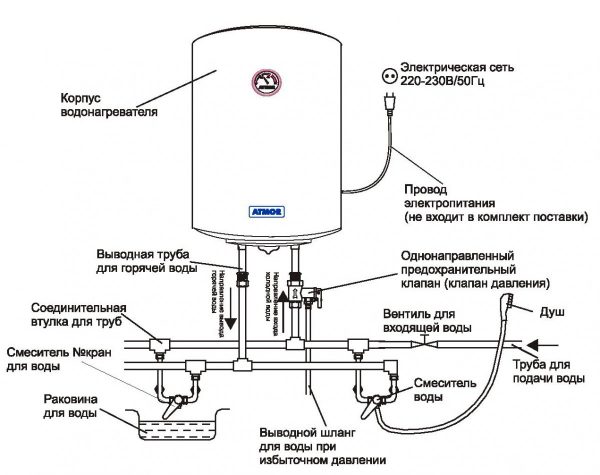

Flow type water heater device
Advantages of an instantaneous water heater:
- Hot water goes without restrictions either in terms of volume or duration of use. It heats up continuously for an unlimited time.
- Modern flow devices are small in size, so they can be installed in any place convenient for you.
- Due to the lack of a tank for accumulating and heating water, such a device can be installed even in a boiler room.
- Flow-through heaters are lightweight, so they can be mounted on any wall.
- There is no need to clean the equipment as there is no tank.
The flow-through equipment also has disadvantages:
- High power (most often 8 - 10 kW). When using such a water heater in everyday life, electricity costs increase.
- When installing an instantaneous water heater, a reinforced cable is installed.And it is also advisable to strengthen the wiring throughout the living space so that the cable can withstand the load when all electrical appliances are turned on.
- It is better to install machines that will turn off during power outages.
- If the power of the device is more than 10 kW, then it needs to be connected only to a three-phase network.

